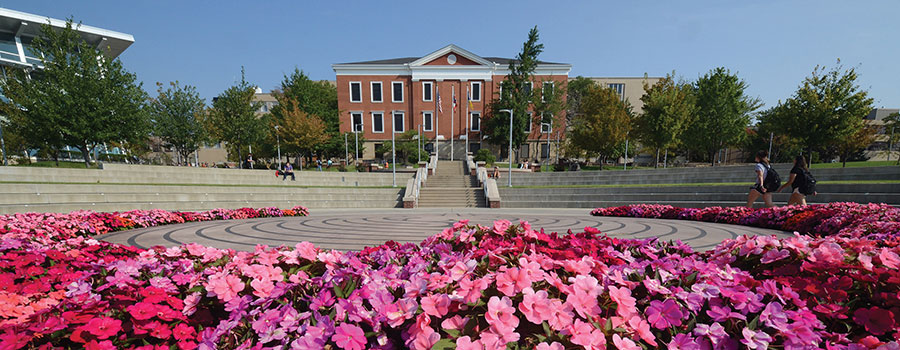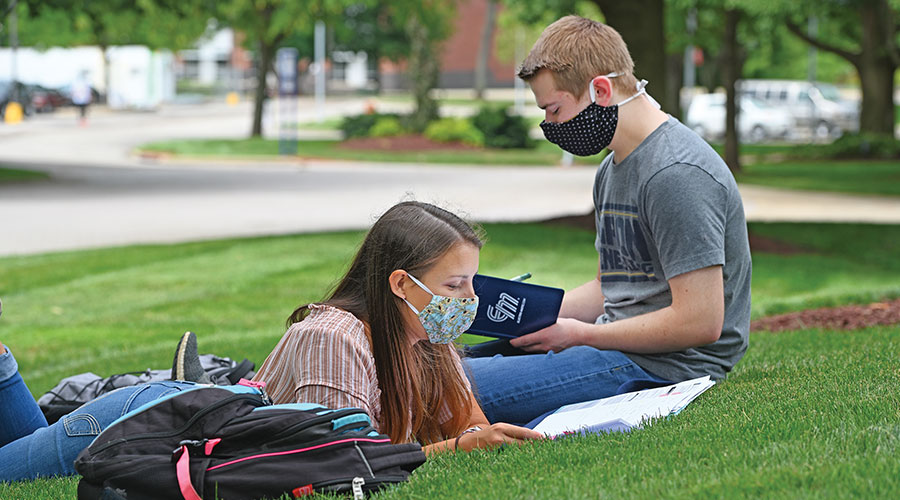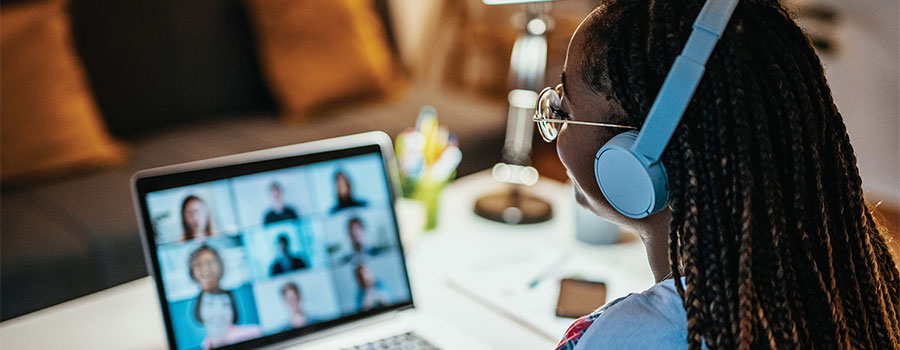
When her iPhone chirped brightly at 7 a.m. on March 11, 2020, Sarah Wales hit “snooze” for the last time. “No need to get up now,” she thought. Her Wednesday morning class had been cancelled the day before when Gov. Mike DeWine asked all Ohio colleges and universities to shift to remote learning.
University of Akron President Gary L. Miller responded by cancelling all classes until March 30, when Spring Break would conclude. He wanted to give faculty and staff time to prepare and make sure students would be able to access online offerings.
Coronavirus. Pandemic. Quarantine.
The words were still new in 2020.
The concept of online learning? “Foreign and just a little frightening,” Wales recalled. She wasn’t sure if she had the self-discipline or patience to sit in front of a computer—alone—instead of interacting with her favorite professors and fellow students.
Across campus—and the nation—countless students wondered the same thing: “Is this the end of my college experience?” “Will I ever be able to graduate?”
Administrators had no idea how COVID19 would impact the foreseeable future.
But on a chilly February morning just two years after closing campus, President Miller stood in front of The Akron Press Club and stated he was “proud to say, without reservation, that The University of Akron is strong and very well-positioned for the future.”
Leading a university through the twisted landscape wrought by a global pandemic is no easy task, but Miller met the challenge head-on.
“Great universities don’t just endure in tough times,” he reflected. “They find strength in their mission and create ways to move ahead. I could not be prouder to have served this university during this challenging time.”
There’s no doubt The University of Akron not only survived one of the most bewildering periods in recent history, but it is now thriving. From new student services and HR policies to unique enrollment pathways and everything in between, UA in 2022 is different—and better.
We asked a few members of the campus community who witnessed firsthand the ripple effects to share their stories—and their hopes for the coming days.
Oh, the irony
Wendy Lampner, director of Online, Continuing and Professional Education, is one person who remembers the morning of March 10, 2020, vividly. “We were already planning to launch 11 new online undergraduate degree programs in the fall of 2020, so on March 10—the day they announced the University was going to go completely online – we already had a meeting scheduled.
“How ironic is that?” Lampner said, laughing. “The meeting was on a Tuesday morning and someone stood up and said, ‘Well, I guess now we have to talk about moving everything online!’”
She credits UA faculty for facilitating the process: “I have an amazing story to tell! Our faculty who knew how to do online teaching stepped up so much. It blew me away.”
The first day her team offered sessions on remote teaching, hundreds arrived. Lampner was pleasantly surprised to see “super advanced faculty who had been to every workshop I had ever had” show up.
Lampner looked at them and said, “You know how to do this. You’ve been teaching online for years.” But they were not there to learn. They simply wanted to help. “That’s how we were able to put thousands of courses online in three weeks,” she added.

Positive Ripples
Two years later, many of the innovations are still positively impacting education, says Lampner. “We had hundreds of faculty who learned how to use Brightspace and Teams, and how to record their lectures. Students love this! Our athletes don’t have to miss class if they are on the road for a game.”
Lampner believes changes forced by the pandemic have permanently improved the student educational experience, even now when they are back in face-to-face classes, because groups like Undergraduate Student Government and other campus organizations can host meetings in Teams
Perhaps most importantly, learning how to use virtual tools will help students when they interview with companies who prefer to hire for remote or hybrid positions. “Almost every employee that I know has a few virtual meetings every week,” Lampner said. “That’s the reality of work today and our students will be ready.”
The University of Akron is better in 2022, said Lampner. “We have dozens of students who are passionately talking about how happy they are that they’ve experienced online learning and, in some cases, how surprised they are by the experience.”
Speaking of work
Sarah Kelly, vice president for human resources at UA, also remembers March of 2020—with a tiny shudder. “We were all at home, working very long hours. We realized quickly the pandemic would have a severe impact on the institution,” Kelly recalled. “I literally rolled out of bed in the morning, sat down at my computer, and didn’t move until midnight.”
The situation was complicated because, prior to the pandemic, UA employees did not work from home: “You came to campus. Period,” said Kelly. “As an institution, we didn’t know how to keep our staff updated or how to boost morale remotely.”
Teams was brand new, resulting in a learning curve, plus some employees did not even have home internet—or they had PCs instead of laptops. “There are a lot of things to work through when you change your mode of work over night,” said Kelly. “But things settled down. We got into a groove and we learned how to work in a different world.”
The acceptance of remote work has been a huge change in the UA culture, Kelly noted. “It’s a win-win because our employees are taking less time off and, as an employer, we are getting more productivity.”
As for the other aspect of HR—hiring—Kelly says there wasn’t a total freeze on hiring during the pandemic: “It was more of a frost. Some critical positions needed to be filled and we did hire some people virtually.”
The federal government helped by putting out guidelines that allowed HR to complete I-9s remotely. The department moved applications online and interviewed via Teams.

The Silver Linings Playbook
Reflecting on the past two years, Kelly credits a number of key people who did tremendous work: “We are a closer community because of what we experienced together.”
As a result of the pandemic, UA created a flex-arrangement policy that continues to allow for remote work and flexible schedules. Each department can determine what works best for them and their employees.
The changes have been “very well received,” said Kelly. “We’ve gotten a lot of positive feedback on how proactive we were. Now in the spring of 2022, we are still getting constructive feedback that allows us to continue improving our policies.”
Finally, Kelly noted, she is happy her team was able to interact with employees they don’t usually encounter during their day-to-day operations: “We’ve been able to develop relationships with other folks on campus and make connections so we can collaborate better. I am excited for what the future will bring.”
And speaking of the future: Sarah, our student who in 2020 was scared and uncertain? Well, she is now preparing to graduate. She feels better equipped to enter a virtual workforce and has learned she can push herself to succeed in the toughest of times.
“Many students, including myself, have overcome huge obstacles in the last two years,” said Wales. “I have friends who got sick, friends whose parents lost their jobs, and friends who dove headfirst into addiction to drown the pain.”
But the UA community is what kept Wales going. “The community mindset—students and faculty and counselors—helped me despite everything the world has thrown at me. I am better for being at The University of Akron during the pandemic and coming out the other side.”
By Janet Chismar-Hardie '92
